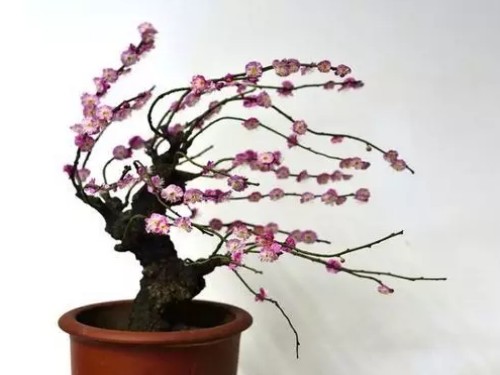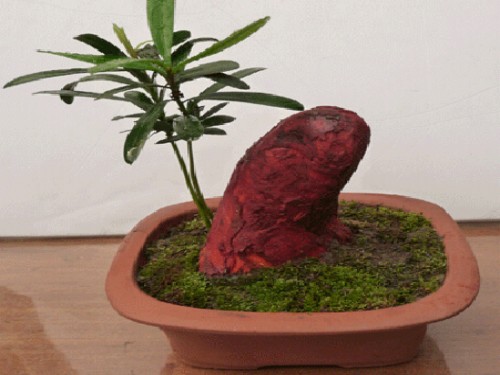Culture method of family potted plum blossom
Plum blossom Rosaceae plum is a deciduous tree with beautiful branches, elegant colors and fragrance. In the winter when the flowers are withering, it is proud to fight snow and meet the cold in full bloom. It represents the indomitable noble quality of the Chinese nation, and its charm, beauty and fragrance are all excellent, ranking first among the top ten traditional famous flowers in our country. Plum blossom in addition to big trees, usually potted, cultivate bonsai, but also can develop Cang Lao Meizhuang. The maintenance method of potted plum blossom is different from other potted plants, so it should be maintained and managed according to its characteristics.
Plum blossom, is China's traditional famous flower, elegant plant shape, bright colors, in the cold winter environment, proud frost and snow, plum blossom first, unique spring, the national period has been designated as the national flower. The noble, strong and modest character of plum blossoms gives people an incentive to work hard, and many flower friends choose potted plum blossoms. In fact, potted plum blossoms are not difficult to raise, but it is difficult to make plum blossoms colorful year after year. What do family potted plum blossoms need to pay attention to in the process of breeding?

1. Basin and soil
Pot planting plum blossom with good permeability tile basin, clay basin is better, purple sand basin can also be, in the basin bottom cushion broken charcoal block or broken hard plastic foam block. The fertile light clayey soil is the best substrate, and the mixed cultivation soil of old mountain mud, pond mud and vegetable garden topsoil can be used. When planting, some bone powder and nitrogen, phosphorus and potassium compound fertilizer should be mixed into the soil as base fertilizer. The planting should be shallow but not root exposed, and deep planting is not easy to blossom. After planting, it should be placed in a semi-shade place and watered once, and then transferred to normal management after 10 days. Turn the pot and change the soil once after flowering in 2 ~ 3 years.
2. Watering
Plum blossoms like moistening and fear of waterlogging, watering should be timely and appropriate. In winter and early spring, it is better to keep the potted soil slightly moist, water permeable once after the flowers are fully grateful, not dry, and often spray water to the branches and leaves and the nearby ground in the evening. In the rainy season, the water should be strictly controlled and watered only when the old leaves are slightly curled and the twigs wilt slightly, which is repeated several times, forcing the new shoots to stop growing, which is conducive to flower bud differentiation; drainage and waterlogging should be carried out in rainy days, and water should be watered once in the morning in sunny days; in the evening, such as dry soil, the leaves should be watered again to prevent excessive drying and dehydration; the amount of water should be gradually reduced after September, and watered once in the afternoon in 1-2 days. In October, flower buds began to germinate into buds, leaves have fallen, water demand is small, see dry soil and then water, basin soil can be slightly dry and moist.
3. Fertilization
Plum blossom like fertilizer is also resistant to barren, do not apply fertilizer at flowering stage, apply nitrogen, phosphorus and potassium compound fertilizer once after flower fade to promote its rejuvenation, when the new shoot is 3-5 cm long, do not apply nitrogen, phosphorus and potassium compound fertilizer once, and no longer apply fertilizer when the new shoot grows to about 18 cm; in late June and early July, 0.2% potassium dihydrogen phosphate solution is sprayed once to promote flower bud differentiation. After falling leaves show buds at the end of autumn, one time nitrogen, phosphorus and potassium compound fertilizer or 0.2% potassium dihydrogen phosphate solution is applied to promote the development and opening of flower buds.
4. Light and temperature
Plum blossom is a positive plant, should be placed in a sunny and well-ventilated place, and should not be placed in the tuyere. Like warm and cold-resistant, winter needs to be stimulated by low temperature in order to blossom and flourish. If the lowest temperature in winter is above-12 ℃, you don't have to enter the house to survive the winter, you can put it in a place away from the wind and the sun. If you want it to open during the Spring Festival, move it to a low greenhouse of 5: 10 ℃ 20 days before the festival, and place it south to west to see more sunshine in the windowsill. After flowering, move to a place of 0: 5 ℃, which can open for 1 month.
5. Pruning
The plum blossom sprouts and branches are strong and resistant to pruning, and the old tree is easy to be rejuvenated. After flowering, the branches that have bloomed are cut short, leaving only 2-3 buds at the base, cutting all the weak branches and diseased branches, cutting off one of the crossed branches and overlapping branches, and cutting them sparsely in the dense place. Pick the heart when the new shoot grows to 20 cm, control its growth, make the nutrition focus on the flower bud differentiation, and the new shoot is too long but few flowers. Through pruning, not only the plant shape is beautiful, but also the ventilation and light transmission is good, and it is not easy to suffer from diseases and insect pests.
6. Turn the basin
Potted plum blossoms generally need to turn the pot every 1 to 2 years, and the time should be arranged after flowering. When turning the basin, remove about 1/3 of the old soil, cut off the withered roots, trim the over-long old roots, and replace them with humus-rich humus leaf soil, mixed with rice chaff ash and sandy soil, so that the potted soil is fat, loose and permeable, and the soil should not be too wet.
6. Diseases and insect pests
Anthracnose may occur in plum blossoms during high temperature and drought in mid-late June, and powdery mildew may occur in July with high temperature, high humidity and poor ventilation. Ventilation and light transmission can be prevented. If diseased branches and leaves are found, they will be cut off and burned, and sprayed with topiramate or carbendazim. The pests of plum blossoms are mainly aphids, which can be sprayed with 1500 times of dichlorvos EC or buried in the soil with carbofuran to kill the plants with poison. It is worth noting that plum blossoms are allergic to phosphorus-containing pesticides and avoid using such pesticides. It is poorly resistant to toxic gases such as sulfur dioxide and may even die in places with serious air pollution.
The treatment method of potted plum blossom without flowering:
The main results are as follows: 1. The environment of potted plum blossoms is too shady, lack of light and poor ventilation. Plum blossoms should be placed in a sunny, well-ventilated and relatively dry place for maintenance.
2. Without timely pruning, there are more long branches and more long branches than short ones, which makes it difficult to form flower buds, so there is less flowering. Pruning the plum blossom starts from the seedlings. When the seedlings are stretched to 25 cm to 30 cm (10 cm to 15 cm in pots), the tip is amputated to promote lateral branches. Leave 3-5 branches as main branches after sprouting, and then go to the top when the branches grow to 20-25 cm (potted seedlings about 10 cm). Adult plum blossoms are usually pruned after flowering.
The pruning principle of plum blossom is mainly light pruning of strong branches and heavy pruning of weak branches. For disease and insect branches, long branches, weak branches and over-dense branches should be cut off from the base at any time, the main and side branches that have flowered should be thinned properly, the lateral branches on the main branches should be cut short by 10 cm, and the long branches should be cut short by 5 to 6 buds, so that the plant branches should be short, tall and dense. Pay attention to the direction of cutting buds when pruning, generally, varieties with drooping branches leave inner buds, varieties with erect or oblique branches leave outer buds, and the cutting mouth should be flat.
3. Insufficient nutrition, failure to change pot soil and fertilization in time, affecting the growth and flower bud differentiation of plum blossoms. The pot should be changed in time after the flower fade in spring, the basin soil should be loose, and some dry organic fertilizer should be added to the basin bottom as base fertilizer; topdressing once in April, 10 days after the new stop growth combined with watering available phosphorus and potassium fertilizer to promote flower bud differentiation; autumn basin soil should be properly moist, and topdressing 2 to 3 times, mainly thin liquid fertilizer; in early January of the second year, when plum blossoms were budding, thin and fast available fertilizer should be added once to promote plum blossom to blossom.
4. Excessive watering or waterlogging in rainy season affected the differentiation of flower buds. The principle of watering is that it is not dry or watered, but it should be treated differently in different growing seasons. It is best to pour the basin upside down in the rainy season to avoid stagnant water; water permeable once every afternoon in summer, replenish individual dried basin soil the next morning, and reduce the amount of water after defoliation in autumn.
Time: 2019-05-31 Click:
- Prev

How to raise sandalwood bonsai
We see all kinds of bonsai in many offices or balconies. Bonsai is a work of art that uses plants and rocks as basic materials to express the natural landscape in the basin. And I like sandalwood, when it comes to sandalwood, I believe many people know that it is also called white sandalwood, it belongs to the sandalwood family evergreen trees. At the beginning of blooming
- Next

Why does the rubber tree lose its leaves?-what if the rubber tree loses its leaves?
Rubber tree is an evergreen tree of Moraceae. It likes high temperature, humid and sunny environment, and can bear shade, but not cold. It is very suitable for indoor beautification and decoration. It is often used to beautify the living room and study. It is also suitable to be arranged on both sides of the foyer and the center of the lobby of large buildings. It is magnificent.
Related
- Fuxing push coffee new agricultural production and marketing class: lack of small-scale processing plants
- Jujube rice field leisure farm deep ploughing Yilan for five years to create a space for organic food and play
- Nongyu Farm-A trial of organic papaya for brave women with advanced technology
- Four points for attention in the prevention and control of diseases and insect pests of edible fungi
- How to add nutrient solution to Edible Fungi
- Is there any good way to control edible fungus mites?
- Open Inoculation Technology of Edible Fungi
- Is there any clever way to use fertilizer for edible fungus in winter?
- What agents are used to kill the pathogens of edible fungi in the mushroom shed?
- Rapid drying of Edible Fungi

